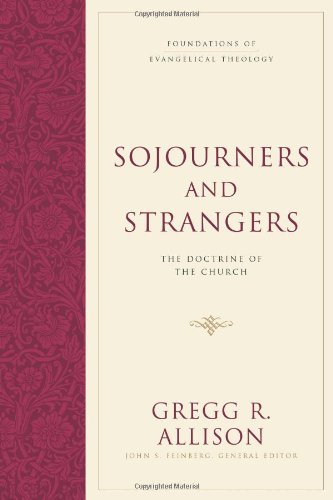A Brief Book Summary from Books at a Glance
About the Author
Gregg R. Allison is professor of Christian theology at the Southern Baptist Theological Seminary. He serves in a variety of academic roles, and is also an elder at his church.
Introduction
Sojourners and Strangers is part of the Foundations of Evangelical Theology series. Allison examines the doctrine of the church with an eye to biblical, theological, and historical developments. He also provides many points of application and evaluates various controversial issues. This is a significant contribution to the subject and should not be ignored.
Table of Contents
Chapter 1 Introduction to Ecclesiology
Chapter 2 The Church of the New Covenant
Chapter 3 Characteristics Regarding the Origin and Orientation of the Church
Chapter 4 Characteristics Regarding the Gathering and Sending of the Church
Chapter 5 The Purity and Unity of the Church
Chapter 6 Church Discipline
Chapter 7 The Offices of the Church
Chapter 8 Types of Church Government
Chapter 9 A Model of Church Governance
Chapter 10 Baptism
Chapter 11 The Lord’s Supper
Chapter 12 Ministries of the Church
Chapter 13 Sojourners and Strangers
Book Summary
Chapter 1: Introduction to Ecclesiology
Our views of ecclesiology need to be grounded in Scripture, but we are also inescapably influenced by our actual experience of church life. The church is the people of God who are saved and baptized through the Spirit into Christ’s body. The universal church consists of every believer since Pentecost, and this church is manifested in local churches. Local churches worship God, are centered on Christ and Scripture, are led by the Spirit, and exist as covenantal, confessional, missional communities. Scripture is wholly sufficient for formulating ecclesiology. Social sciences and even liturgy must be subordinated to Scripture. Using Scripture, one’s view of the church will be highly influenced by the interpretation of the continuity or discontinuity between the Testaments. There is a moderate discontinuity between the old and new covenants (i.e. there is not absolute continuity, neither is there a total separation). In terms of the nation of Israel and the church, there is discontinuity (i.e. they are distinct groups—Israel in the OT is not the church). The Book of Acts is generally normative for the church (i.e. it is completely authoritative even in its narrative, but not every single descriptive detail is a prescription). Even in the Epistles, proper hermeneutics are required to see what is a cultural or specific instruction, rather than a universally binding obligation (even though every word in Scripture is inspired and authoritative). Theologians have tried to construct ecclesiologies on the lines of function, teleology, or ontology. We should approach ecclesiology ontologically, since we need to know what the church is if we are to know what it should do and where it is going. The doctrine of ecclesiology is not the most important doctrine in theology, but it is significant and ought to be studied. The church is part of the plan of God and reveals his glory. It exalts Christ. It is the work of Christ to save and build the church.
Chapter 2: The Church of the New Covenant
The NT data highlights that local churches and the universal church are at the forefront of the concept of church. By far the most common reference is to local church gatherings. Also prominent, however, is the universal church (i.e. all believers who are part of Christ’s body). God structures his dealings with human beings according to covenants. God relates to the church through the new covenant. The Mosaic covenant failed because of the sin of the people, and it was prophesied that it would be replaced by a new covenant. One of the marks of the new covenant was a fresh and unprecedented outpouring of the Spirit. In the new covenant community, every member knows the Lord and has experienced forgiveness of sins. The Gospels emphasize the future outpouring of the Spirit in connection with Christ, and this is fulfilled at Pentecost. In Paul’s letters and in Hebrews, we find a strong contrast between the two covenants. Circumcision is gone; baptism and the Lord’s Supper are present. The church began at Pentecost. During his ministry on earth, Jesus indicated the founding of the church was in the future, and it occurred with the outpouring of the Spirit. As the new covenant community, the church did not. . .
[To continue reading this summary, please see below....]The remainder of this article is premium content. Become a member to continue reading.
Already have an account? Sign In
